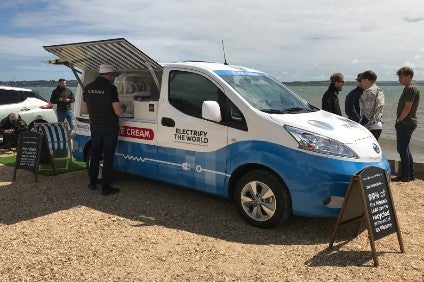
Nissan claims to have taken the ICE (internal combustion engine) out of the ice cream van, creating an all-electric, zero-emission concept for Clean Air Day in the UK on 20 June. Not uncoincidentally, the van was shown to UK media attending the local launch of the extended-range Leaf+ the same day.
Although it should be stressed, the van is only really at a concept stage (it was actually plugged in to a power source when we saw it), Nissan has joined with Mackie’s of Scotland, an ice cream producer powering its family-owned dairy farm by renewable wind and solar energy.
While it’s tempting to make tart remarks about ‘how do you generate any solar energy in Scotland’s gloomy climate?’ the fact remains they do and the (soft serve) ice cream is delicious. The project, Nissan says, “demonstrates how a ‘Sky to Scoop’ approach can remove carbon dependence at every stage of the ice cream journey.
Essentially, the EV van replaces the current type where a diesel engine – idling for hours if not all day – powers refrigeration equipment. Nissan aims to eventually power the van to and from its ‘pitch’ using the inbuilt battery pack while special energy packs keep the ice cream frozen. They’re not yet anywhere near ‘all day’ mode but battery packs will get more powerful over time – the Leaf+ manages about 250 miles on a charge now versus about 100 (if you were lucky) for the 2010 original.
With diesels criticised for producing harmful emissions, including black carbon, when left idling, some UK towns and cities are now looking to ban or fine these vehicles. Nissan’s concept offer a potential solution for vendors looking to reduce their carbon footprint, and offer customers a better experience – you and your children are not breathing in fumes waiting for your iced treat. Should any sort of joined-up thinking actually happen in the UK, councils might install a decent charger at selected popular spots and rent the electrified ‘pitch’ to vendors.
The prototype van is based on the full electric e-NV200 van and is a working demonstration of the automaker’s Electric Ecosystem, combining a zero-emission drivetrain, second-life battery storage and renewable solar energy generation.

US Tariffs are shifting - will you react or anticipate?
Don’t let policy changes catch you off guard. Stay proactive with real-time data and expert analysis.
By GlobalDataThe van’s motor is driven by a 40kWh battery, the on-board ice cream equipment, including a soft-serve machine, freezer drawer and drinks fridge, are powered by the newly unveiled Energy Roam which goes on sale later in 2019. Designed for both professional and leisure applications, this is a portable power pack that uses lithium-ion cells recovered from early first-generation Nissan electric vehicles (produced from 2010 onwards). This provides a sustainable second-life for Nissan EV batteries.
The van has an all-electric driving range of up to 124-miles (WLTP Combined) between charges. The two Roam units have a combined storage capacity of 1.4kWh and can each output power at up to 1kW. They can be recharged either from a 230v mains supply (a full recharge takes about an hour), or the solar panel array on the van’s roof (a full recharge in 2-4 hours). If you’ve got one of those booster battery packs to recharge your phone when away from the mains, you’ll get the idea. Same on a much bigger scale. They’re made using second-life batteries recovered from first generation Leafs which have come to the end of their life and are a great example of sustainable energy technology.
While most diesel UK vans have a vendor selling from inside, the smaller Nissan concept serves from a hatch that opens in the side of the vehicle, with the vendor dispensing ice cream standing next to the van – a customer-facing experience instead of being separated by an elevated counter. Payment can be by cash, but also contactless bank card and smartphones via a ‘tap-to-pay’ panel mounted on the side of the van.
Instead of a jingle to attract customers – not always popular with parents – the concept has a smart button that generates a tweet of the van’s precise location using the global addressing service What3Words which divides the world into 3m x 3m locations, each with a unique three word address. Customers can easily find the van in a park or seafront location where normal street addressing would not apply.
Bi-directional charging capability means owners could even income through the winter – when the van is less frequently used. Through a V2G (Vehicle-to-Grid) charger, the e-NV200 battery can be used to store surplus energy from the national grid (for example renewable wind and solar energy), and then provide it back to the grid when needed. This technology can help balance out the peaks in national energy demands, as well as providing EV owners with additional revenue from their vehicle when it’s not being driven.



